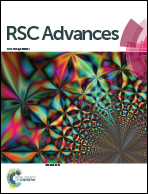Supported ionic liquid [Bmim]FeCl4/Am TiO2 as an efficient catalyst for the catalytic oxidative desulfurization of fuels†
Abstract
High activity oxidation of sulfur compounds to sulfones in extraction coupled with catalytic oxidative desulfurization (ECODS) system catalyzed by supported ionic liquid [Bmim]FeCl4/Am TiO2 was reported. The catalysts were analyzed by thermogravimetric (TG) analysis, X-ray diffraction (XRD), Fourier transform infrared spectroscopy (FT-IR) and X-ray photoelectron spectroscopy (XPS). It was found that [Bmim]FeCl4 and Am TiO2 had a synergistic effect on the desulfurization system. Effects of calcination temperature of the catalyst and various reaction conditions on the catalytic activity of desulfurization were investigated. Moreover, GC-MS analyses were employed to prove the process of the desulfurization. As a solid catalyst, the supported ionic liquid could be separated from the reaction easily. The recycling tests showed that the desulfurization efficiency remained 100% after reusing it for 25 times. Therefore, the ECODS system has excellent reusability and is promising for industrial applications for catalytic oxidative desulfurization.
![Graphical abstract: Supported ionic liquid [Bmim]FeCl4/Am TiO2 as an efficient catalyst for the catalytic oxidative desulfurization of fuels](/en/Image/Get?imageInfo.ImageType=GA&imageInfo.ImageIdentifier.ManuscriptID=C5RA00999E&imageInfo.ImageIdentifier.Year=2015)
- This article is part of the themed collection: Ionic Liquids: Editors collection for RSC Advances

 Please wait while we load your content...
Please wait while we load your content...